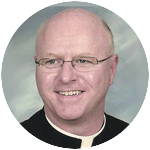
Msgr. Joseph Prior
(See the readings for the Fourth Sunday of Lent, March 14)
“Rejoice, O Jerusalem,” is the entrance antiphon for this Sunday’s liturgy. The day is sometimes called Laetare Sunday, “laetare” meaning “rejoice.” During our journey through Lent the celebration for this Sunday calls for the priest and deacon to wear rose-colored vestments. The liturgy reminds us that as we journey through Lent we have great reason to rejoice for the Lord loves us, and through his passion, death and resurrection frees us from sin and death.
The first reading from Second Chronicles first recalls the situation in Israel that led to the Babylonian exile. “Infidelity” was added to “infidelity.” Prophets were sent and ignored. The Lord’s Temple was profaned. Then the Babylonians came, conquered and destroyed the country. The Temple of the Lord was desecrated and destroyed as was the holy city of Jerusalem. The peoples were exiled as captives and taken to the faraway lands of Mesopotamia (present day Iraq).
The pain of exile and the loss of Jerusalem and the Promised Land is reflected in Psalm 137. “By the rivers of Babylon, we sat and wept when we remembered Zion … For there our captors asked us for songs, and our despoilers urged us to be joyful … How could we sing a song of the Lord in a foreign land? If I forget you Jerusalem, let my right-hand wither.”
[hotblock]
The rejoicing comes not in response to infidelity or exile, rather that the Lord remembered his people, forgave their sins and redeemed them through the hand of Cyrus, King of Persia. Approximately 50 years after the exile began, the Babylonians were defeated by the Persians. Cyrus issued a decree allowing the captured peoples to return home and to rebuild the Temple, the house of the Lord. There the people would sing again in joy.
The revelation of God’s love and mercy will reach its fulfillment in Jesus the Christ. The Gospel passage recalls Jesus’ comparing his passion, death and resurrection to a much earlier event in the life of Israel. During the time that they were wandering in the desert for 40 years, a terrible pestilence came upon them. Many people were dying. The people called out to the Lord acknowledging their sins and asking for deliverance.
The Lord instructed Moses to fashion a serpent in bronze and mount it on a pole. He did this. Whenever someone afflicted would look on the image, they were healed. The Lord heard the cry of the people and they were delivered. Jesus sees this event as a foreshadowing or a preparation for his being lifted up on the wood of the cross. The reason is this: “For God so loved the world that he gave his only Son, so that everyone who believes in him might not perish but might have eternal life. For God did not send his Son into the world to condemn the world, but that the world might be saved through him.”
This is why the image of the cross plays such a prominent and visible role in our lives, our churches, our buildings and our homes. It is through the cross that God’s judgment of mercy comes upon us and we are delivered, at a great cost on his part, from sin and death. The “lifting up” of Jesus does not end with the cross. After the three days in the tomb, he is “lifted up” and rises from the dead — the clear manifestation of his victory.
[hotblock2]
Two other themes that run through the Gospel are also mentioned. The first being “light and darkness,” the other “truth.” Jesus is the “light” that comes into the world which many times is associated with “darkness.” When the term is used this way it does not mean the good things of the world but the bad, those things that are not of God.
So a choice has to be made. Moving toward and into the light is a choice for Christ, and for the mercy and life he offers. Moving toward the darkness is a choice to remain separated and alone.
“Truth” is the second theme. Later in the Gospel Jesus will say: “I am the way, and the truth, and the life; no one comes to the Father except through me.” Living in Christ is the way in which we come to the light. A choice for Christ is the choice for truth and light.
Our journey in Lent is moving toward the celebration of Jesus’ passion, death and resurrection – the Paschal Mystery. Our penitential practices during the season recall the great end to which we are directed – mercy and life. Into the sufferings of life whether they be great or small, individual or shared, comes the light of life. Jesus has embraced human suffering and delivers us from its power.
St. Paul says it this way: “God, who is rich in mercy, because of the great love he had for us, even when we were dead in our transgressions, brought us to life with Christ — by grace you have been saved — raised us up with him, and seated us with him in the heavens in Christ Jesus, that in the ages to come he might show the immeasurable riches of his grace in his kindness to us in Christ Jesus. For by grace you have been saved through faith.”
And so we rejoice.
***
Msgr. Joseph Prior is pastor of Our Lady of Grace Parish, Penndel, and a former professor of Sacred Scripture and rector of St. Charles Borromeo Seminary.



Share this story